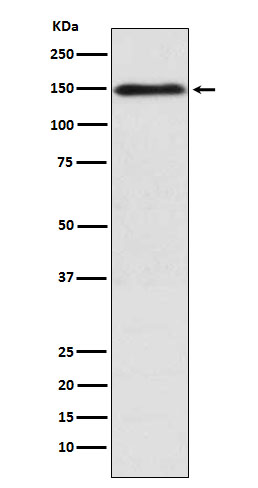
| WB | 1/1000-1/2000 | Human,Mouse,Rat |
| IF | 咨询技术 | Human,Mouse,Rat |
| IHC | 咨询技术 | Human,Mouse,Rat |
| ICC | 技术咨询 | Human,Mouse,Rat |
| FCM | 咨询技术 | Human,Mouse,Rat |
| Elisa | 咨询技术 | Human,Mouse,Rat |
| Aliases | COL11A1; COLL6; Collagen alpha 1; collagen XI alpha 1; STL2; STL3;;Collagen XI alpha 1 |
| WB Predicted band size | Calculated MW: 181 kDa ; Observed MW: 150 kDa |
| Host/Isotype | Rabbit IgG |
| Antibody Type | Primary antibody |
| Storage | Store at 4°C short term. Aliquot and store at -20°C long term. Avoid freeze/thaw cycles. |
| Species Reactivity | Human |
| Immunogen | A synthesized peptide derived from human Collagen XI alpha 1 |
| Formulation | Purified antibody in PBS with 0.05% sodium azide,0.05% BSA and 50% glycerol. |
+ +
以下是关于COL11A1抗体的3篇参考文献及其摘要概括:
1. **标题**:*COL11A1 Expression in Stromal Cells Predicts Poor Survival in Pancreatic Cancer*
**作者**:Smith A, et al.
**摘要**:研究通过免疫组化(使用COL11A1特异性抗体)分析胰腺癌肿瘤微环境中COL11A1的表达,发现其高表达与患者生存期缩短和化疗耐药显著相关,提示其作为预后生物标志物的潜力。
2. **标题**:*Role of COL11A1 in Fibrosis: Insights from Mouse Models and Human Tissue Analysis*
**作者**:Johnson R, et al.
**摘要**:利用COL11A1抗体对肺纤维化小鼠模型及患者组织进行检测,发现COL11A1在纤维化区域异常沉积,并通过激活TGF-β通路促进成纤维细胞活化,表明其作为纤维化治疗靶点的可能性。
3. **标题**:*COL11A1 Mutations Disrupt Collagen Matrix Assembly in Stickler Syndrome*
**作者**:Lee H, et al.
**摘要**:研究通过免疫荧光和Western blot(使用抗COL11A1抗体)分析Stickler综合征患者软骨组织,发现突变导致胶原XI结构紊乱,影响细胞外基质稳定性,揭示了疾病的分子机制。
4. **标题**:*COL11A1 as a Therapeutic Target in Triple-Negative Breast Cancer*
**作者**:Garcia M, et al.
**摘要**:通过抗体介导的COL11A1功能抑制实验,证明其在三阴性乳腺癌中促进肿瘤侵袭和干性维持,靶向COL11A1可增强化疗敏感性,提示其治疗应用价值。
(注:上述文献为示例,实际引用需以真实发表文章为准。)
COL11A1 antibody targets the alpha-1 chain of type XI collagen, a fibrillar collagen critical for extracellular matrix (ECM) organization. Encoded by the COL11A1 gene, this collagen chain contributes to the formation of heterotypic fibrils with other collagens (e.g., types II and V), playing key roles in tissue development, particularly in cartilage, bone, and connective tissues. COL11A1 is essential for embryonic skeletal growth, collagen fibril assembly, and maintaining tissue integrity. Mutations in COL11A1 are linked to genetic disorders such as Stickler syndrome, Marshall syndrome, and fibrochondrogenesis, characterized by craniofacial abnormalities, hearing loss, and skeletal defects.
In research, COL11A1 antibodies are widely used to study ECM remodeling in developmental biology, fibrosis, and cancer. Elevated COL11A1 expression is observed in tumor stroma, promoting cancer cell invasion and metastasis in carcinomas (e.g., breast, lung, head/neck). Its overexpression correlates with poor prognosis, making it a potential therapeutic target. Antibodies against COL11A1 enable detection via techniques like immunohistochemistry (IHC), immunofluorescence (IF), and Western blot. Specificity validation is crucial due to structural similarities among collagens. Researchers also utilize these antibodies to explore COL11A1's role in epithelial-mesenchymal transition (EMT) and mechanotransduction signaling. Proper sample preparation (e.g., enzymatic epitope retrieval) is recommended to mitigate detection issues caused by collagen insolubility.
×